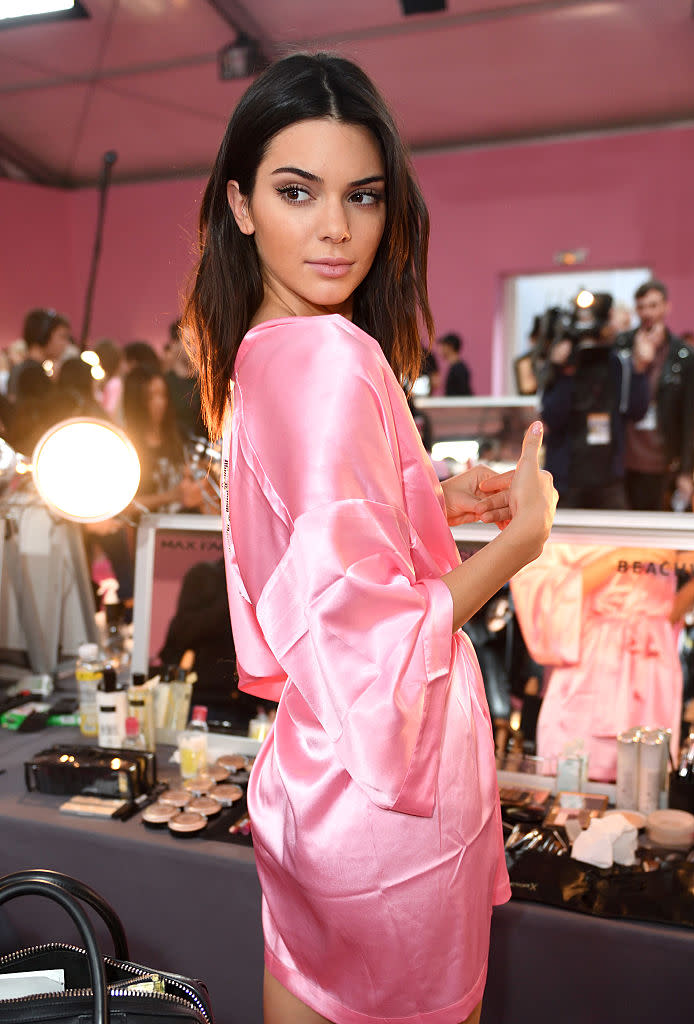Kendall Jenner Has a ‘Skinny Wall’ in Her Living Room

Three weeks ago, Kendall Jenner posted a photo to her Instagram of her Christmas tree — but what many of her fans noticed more was the backdrop: a peaceful pink wall. In the latest post in her app, Jenner addressed her paint-color choice. It’s a shade called Baker-Miller Pink, which she claims chills her out and keeps her from overeating.
“I decided to paint [the wall] pink because while I was trying to figure out what I wanted to do with the room, I went to dinner with friends and they had just gone to the ‘Human Condition’ exhibition at a former hospital in LA,” she wrote. “They were telling me there’s a pink room at the exhibit that had an explanation of the color choice: Baker-Miller Pink is the only color scientifically proven to calm you AND suppress your appetite. I was like, ‘I NEED this color in my house!’ I then found someone to paint the room and now I’m loving it!”
A photo posted by Kendall (@kendalljenner) on Dec 9, 2016 at 8:35am PST
It turns out Baker-Miller Pink is indeed a color phenomenon. The hue is also referred to as Drunk Tank Pink, as it’s been used in jail cells to calm violent prisoners, according to Color Matters. And Hillsborough Regional Juvenile Detention Center West in Tampa even employed the color in a room used to simmer down aggressive minors, says Apartment Therapy.
Alexander Schauss, PhD, director of the American Institute for Biosocial Research in Tacoma, Wash., studied the effects of the color pink on human behavior, and published his findings in a paper published in 1979. In it, he writes, “After experimenting with hundreds of shades of pink, I finally identified a shade of pink … that seemingly had a maximal effect on reducing hyperexcitability. This color would later be called ‘Baker-Miller Pink.'”
So Schauss suggested experimenting with the color by using it in a seclusion room at the Washington State Criminal Justice Training Commission, where he was teaching a course. Instead, the “entire interior of one admissions cell at the Center” was painted in the hue. After 156 consecutive days of monitoring, staff at the facility reported that since the color had been present in the cell, “there have been no incidents of erratic or hostile behavior during the initial phase of confinement.”
A photo posted by josé ???? (@neathavoc) on Dec 24, 2016 at 8:41pm PST
In addition, Schauss reported that a maximum of 15 minutes of exposure to the color was all it took for the behavioral effects to become obvious, and that those effects lasted about 30 minutes after the inmate was removed from the cell. He said the color, described as “kind of like Pepto-Bismol, only deeper,” was more effective in a smaller space.
According to Apartment Therapy, what’s happening physiologically is that Baker-Miller Pink lowers heart rate, pulse, and respiration. That may or may not be related to the appetite-reduction component, which Schauss confirmed. In his paper, he said that further research was conducted by the Health, Weight, and Stress Clinic at Johns Hopkins University, and that “their research over four years on nearly 1,700 subjects revealed a peculiar appetite suppression effect by Baker-Miller Pink, during their studies of its stress-suppressing effect. This effect, of suppressing the desire for food, was confirmed in more than one-third of subjects seeking methods for weight control at the Hospital’s Clinic.”
A team at Johns Hopkins studied the color’s calming effects as well, and observed that appetite reduction was “a peculiar side effect,” according to Cabinet magazine.
Sound too good to be true? It might be. Color Matters says, “There’s no proof that the [calming] reactions lasted longer than 15-30 minutes.” The site adds, “Once the body returns to a state of equilibrium, a prisoner may regress to an even more agitated state.” And Cabinet reports that officials at the county jail in Santa Clara, Calif., painted a holding cell with Baker-Miller Pink and placed inmates in the room. “This resulted in the prisoners scratching the paint off the walls with their fingernails,” the site says.
That said, no one seems to have debunked the appetite-suppression claim for Baker-Miller Pink, so it seems to actually be true. Want to have your local home-improvement store mix up a gallon of the color? Just tell them to formulate it by combining R:255, G:145, and B:175.
And if you’re wondering how Baker-Miller Pink got its moniker, well, according to Therapy Color, Schauss was so appreciative of the two prison directors, warden Gene Baker and commander Miller, who graciously agreed to carry out his experiment that he named the color after them.
Follow us on Instagram, Facebook, and Pinterest for nonstop inspiration delivered fresh to your feed, every day.

